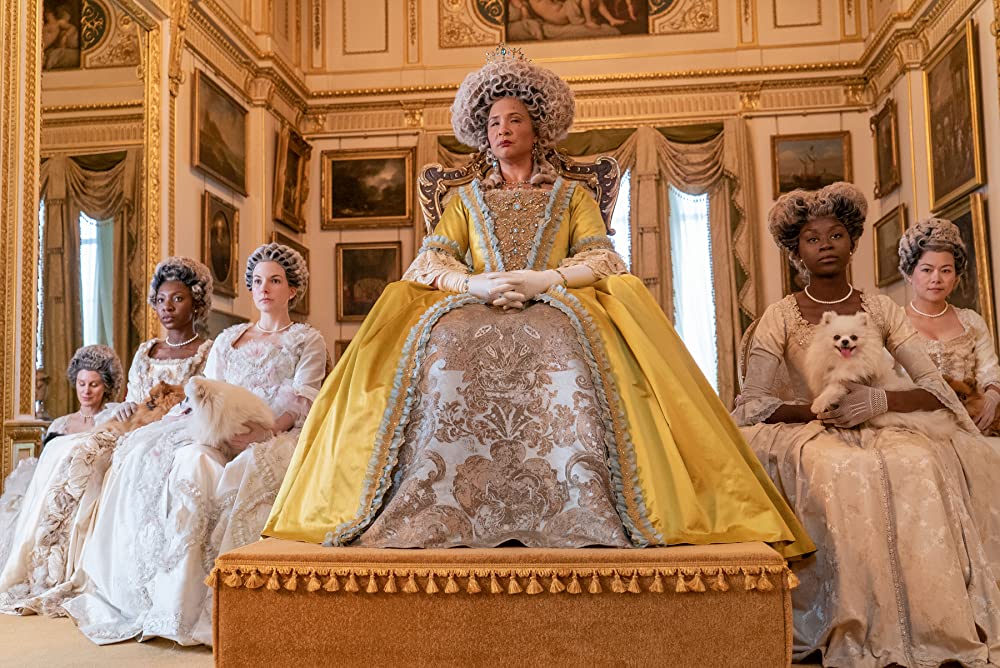Queen Charlotte (Golda Rosheuvel) with her court. (Photo credit: Liam Daniel/Netflix)
Bridgerton is currently facing a firestorm of controversy regarding its use of a rape scene from the original novels. I haven’t read the Bridgerton novels, so I didn’t know about this until I read about the series on Twitter. However, I was about four episodes in and had already formulated some opinions about the show.
To be fair to my experience watching the show, I will review half of Bridgerton with the viewpoint I had before reading about the scene in question and the other half after viewing the offending scene. The series has a collection of good and bad elements within it, similar to Lovecraft Country, which also suffered from problematic elements despite its insistence on uplifting and educating its viewers.
With that said, here are my first thoughts about the series.
I’m a lover of period pieces, and I’ve longed for a show or film that features diversity among its fluffy dresses and British-tinged escapism. For the first four episodes, Bridgerton provided me that escape.
With Julie Andrews’ Lady Whistledown providing pithy narration for this series full of juicy intrigue and scandal, Bridgerton hits all the sweet spots fans of period drama love. We had the drama given the only way Shonda Rhimes can. We had extravagant costumes, despite them being more like modern clothes styled in a late 18th-century fashion. We have cute women and devastatingly handsome men. And, of course, we have tons of romance.
But what makes Bridgerton even better is that the show is filled with people of color. Like Still Star-Crossed before it, Bridgerton has created Ye Olde Europe’s story that includes the diversity written out of history while keeping the story in the realm of fantasy (for the most part–more on that later). Indeed, Europe wasn’t as white as history books and even historians would have you believe. Case in point: Bridgerton includes Queen Charlotte (Golda Rosheuvel), a royal with African heritage and is considered by many to be a Black queen of England. Indeed, Queen Charlotte and Lady Danbury (Adjoa Andoh) are my favorite characters from the series.
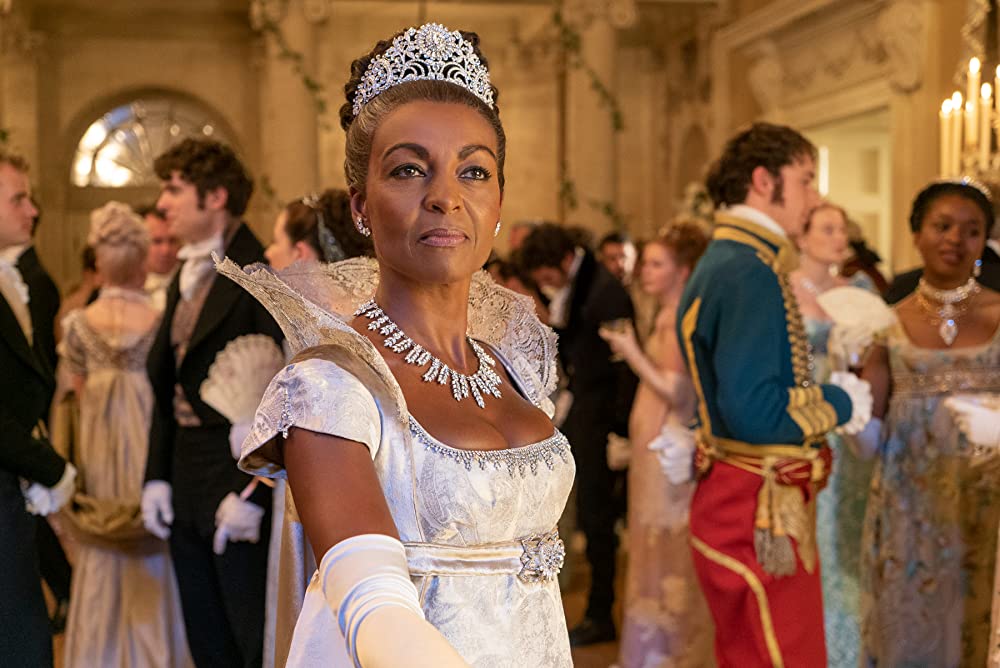
The irony is that Bridgerton’s author, Julia Quinn, has said some interesting things about writing (or not writing) people of color into her books. Bridgerton series creator Chris Van Dusen and producer Shonda Rhimes have shown how you can transform a property into something that can welcome people of all stripes. But, just because there are some brown faces in the series doesn’t mean Bridgerton has suddenly become perfect.
In the first four episodes I’ve watched, I noted how there seems to be a color line for Black actors. The Black actors in the main cast, Rosheuvel, Andoh, Ruby Barker, Regé-Jean Page and Kathryn Drysdale (who plays prominent secondary character Genevieve Delacroix, the tailoress for high society), are all people who could pass the storied paper bag test. That is, every Black person who is pertinent to the story are lighter-skinned. Darker-skinned people are either background fodder or, in the case of Simon’s father, the Duke of Hastings (Richard Pepple), abusive and evil. Indeed, Simon’s mother (Daphne Di Cinto) is lighter-skinned, virtuous, and dies a martyr of sorts in childbirth. She’s the angelic counter to the Duke’s devilishness.
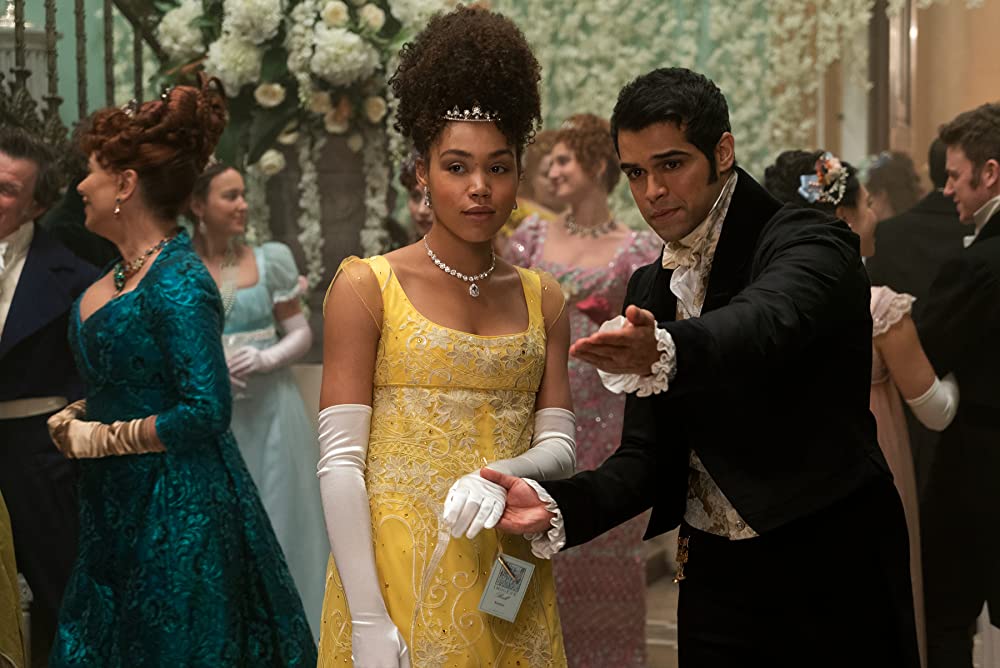
On top of colorism, there’s sizeism, with Penelope Featherington (Nicola Coughlan) feeling left out like an ugly duckling just because of her weight. Penelope isn’t ugly. Actually, according to Geri Walton, a gentleman in the late Georgian period–a few years before the Regency period Bridgerton is set–described his perfect woman this way: “Stature, neither too high nor too low; Neither too fat nor too lean…The cheeks rounding away in softened profils [sic], and dimpled…The chin rather round, plump, and ending with a dimple…A white hand, plump and long…The shape noble, easy, and disengaged.” To me, this sounds more akin to Penelope than it does to the diamond of the season, Daphne Bridgerton (Phoebe Dynevor). It’s even more apparent that beauty standards favored Penelope more than Daphne when you consider Queen Louise of Prussia, who Geri Walton wrote was considered the most beautiful woman in Europe at the time.
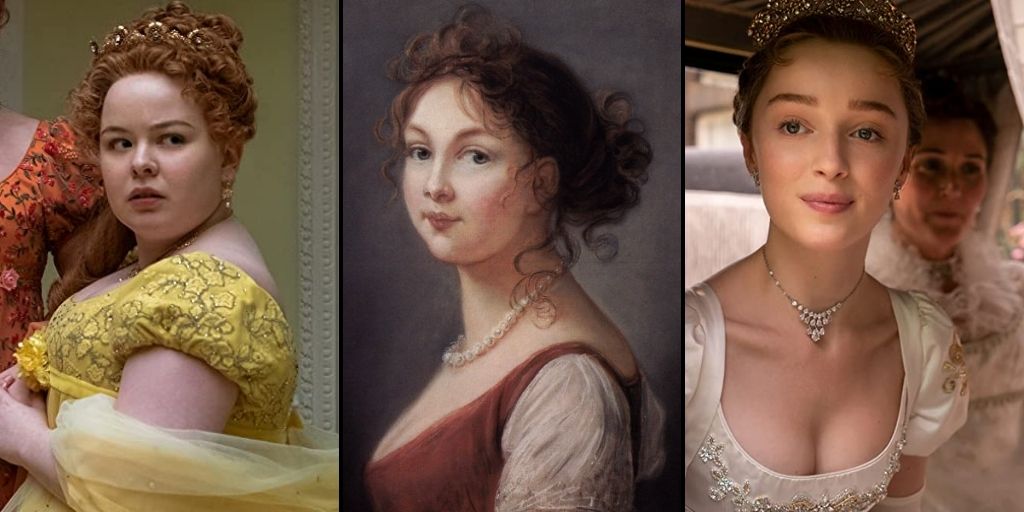
Penelope’s struggles with finding a suitor could be about anything else other than her weight, considering how some men of the time might consider her charmingly “healthy” by their standards. Yet, Penelope bears the albatross many modern women carry–the albatross of untenable body standards. I feel like viewers who already struggle with this will not find any relief with Penelope’s characterization. I think it’s a disservice to the character and viewers as a whole since there’s more to Penelope than how she measures up against Daphne.
Penelope also has issues measuring up to her cousin Marina (Barker), who gave Daphne a run for her money as a potential diamond of the social season. But like Penelope, Marina is also sidelined with an albatross of a storyline. Instead of struggling with weight, though, Marina struggles with pregnancy and love. Her aunt, Lady Featherington (Polly Walker), forges a letter from her love, who is fighting for Britain in Spain. The letter makes Marina believe her love doesn’t want anything to do with her and their baby, making her pursue a path towards marriage and stability. Of course, this will come back to bite Lady Featherington in the butt and potentially ruin Marina’s standing. But the journey towards this bitter end isn’t enjoyable in the least. It’s a waste of what could have been a dynamic character. Instead, Marina becomes a foil to Penelope in terms of looks, not to mention a tragic character to be doomed to lose in love.
The most head-scratching moment within these four episodes is when Simon (Page) and Lady Danbury (Andoh) have a strange conversation about how Queen Charlotte’s marriage into British aristocracy elevated Black people in society. That conceit couldn’t be further from the truth. Even though Britain didn’t have slavery as law, Britain still engaged in racism and servitude, even with Queen Charlotte on the throne.
Also, the idea that love conquers all is not entirely accurate. I believe love is the most potent force on the planet, turning enemies into friends and turning movements into worldwide change. But love can only change people if there is a willingness to allow that love to come into one’s heart. In other words, racism doesn’t dissolve just because love exists. Racism dissolves when people accept all the facets of love–forgiveness, acceptance, growth, sorrow, grief–and allow love to change them into better, more compassionate people.
This discussion about love might sound like an esoteric tangent. Still, it’s a discussion that partially occurs during the exchange Lady Danbury and Simon have about the state of Black Britain thanks to Queen Charlotte. And indeed, Queen Charlotte herself disproves Lady Danbury’s feelings about love conquering all since she could care less about her husband’s health. But most of all, the discussion about Black Britain was the clunkiest way possible Bridgerton could inject racial politics into the show. It brought me out of the show’s fantasy since I assumed the show would not even try to address the difficult topic of race among its escapism, even though it flirts with historical accuracy via Queen Charlotte. But since Bridgerton wants to make its world an even more significant part of our reality, it will have to address race in a more realistic way than one marriage changing the path of Black life in Britain.
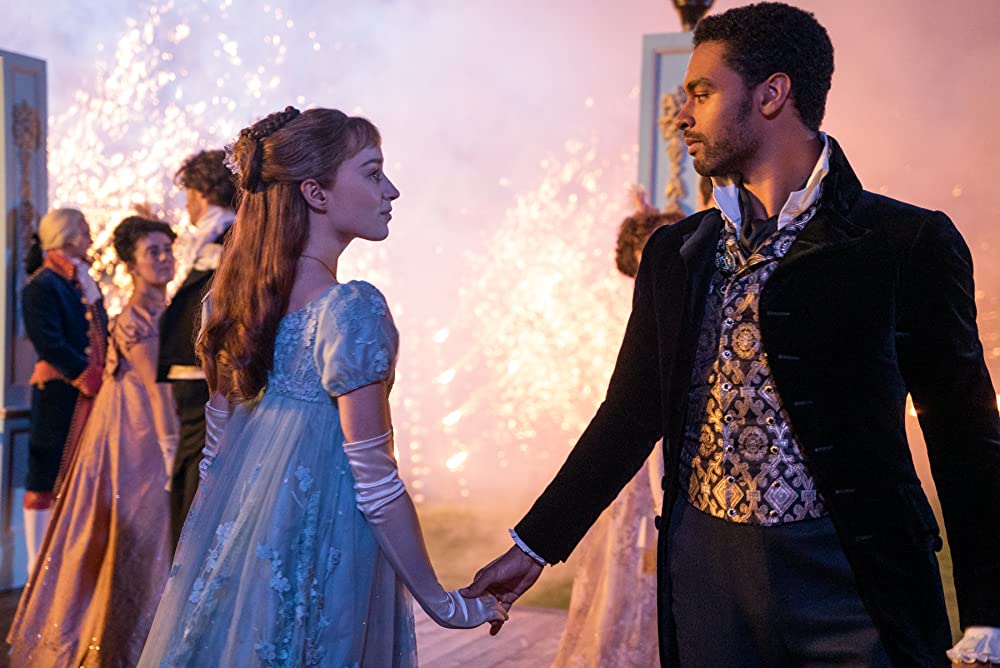
Other viewers have remarked on Bridgerton‘s ableism, such as Simon being bullied by his father for his stuttering and the implication that Simon can’t be great with his speech impediment. I’ll have to do some more research and uplift other people’s writings on this topic since I don’t want to misspeak. So, expect some links from other people’s reviews regarding Bridgerton‘s ableism in the future.
Overall, though, the first four episodes are cool for what they are. I appreciate seeing a more diverse version of Georgian society. I could belong in that world, at least through the veneer Bridgerton gives us. But I hope the second half of the season can somehow expand on what we’ve seen. From what I’ve heard about possible sexual assault, the hopes are quickly waning fast. But at least the first half of Bridgerton has shown the potential the series has, despite its missteps.
